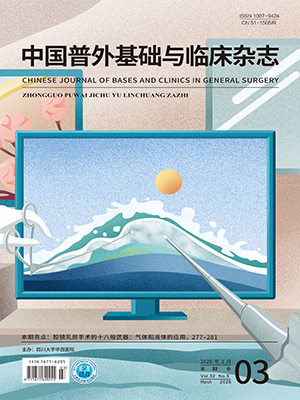| 1. |
Pacini F, Fugazzola L, Lippi F, et al. Detection of thyroglobulin in fine needle aspirates of nonthyroidal neck masses: a clue to the diagnosis of metastatic differentiated thyroid cancer. J Clin Endocrinol Metab, 1992, 74(6): 1401-1404.
|
| 2. |
Frasoldati A, Pesenti M, Gallo M, et al. Diagnosis of neck recurrences in patients with differentiated thyroid carcinoma. Cancer, 2003, 97(1): 90-96.
|
| 3. |
Uruno T, Miyauchi A, Shimizu K, et al. Usefulness of thyroglobulin measurement in fine-needle aspiration biopsy specimens for diagnosing cervical lymph node metastasis in patients with papillary thyroid cancer. World J Surg, 2005, 29(4): 483-485.
|
| 4. |
Jeon MJ, Park JW, Han JM, et al. Serum antithyroglobulin antibodies interfere with thyroglobulin detection in fine-needle aspirates of metastatic neck nodes in papillary thyroid carcinoma. J Clin Endocrinol Metab, 2013, 98(1): 153-160.
|
| 5. |
Lee JH, Lee HC, Yi HW, et al. Influence of thyroid gland status on the thyroglobulin cutoff level in washout fluid from cervical lymph nodes of patients with recurrent/metastatic papillary thyroid cancer. Head Neck, 2016, 38 Suppl 1: E1705-E1712. doi: 10.1002/hed.24305.
|
| 6. |
Duval MADS, Zanella AB, Cristo AP, et al. Impact of serum TSH and anti-thyroglobulin antibody levels on lymph node fine-needle aspiration thyroglobulin measurements in differentiated thyroid cancer patients. Eur Thyroid J, 2017, 6(6): 292-297.
|
| 7. |
Zhang X, Howell JM, Huang Y. Cervical lymph node fine-needle aspiration and needle-wash thyroglobulin reflex test for papillary thyroid carcinoma. Endocr Pathol, 2018, 29(4): 346-350.
|
| 8. |
Pacini F, Schlumberger M, Dralle H, et al. European consensus for the management of patients with differentiated thyroid carcinoma of the follicular epithelium. Eur J Endocrinol, 2006, 154(6): 787-803.
|
| 9. |
American Thyroid Association (ATA) Guidelines Taskforce on Thyroid Nodules and Differentiated Thyroid Cancer, Cooper DS, Doherty GM, et al. Revised American Thyroid Association management guidelines for patients with thyroid nodules and differentiated thyroid cancer. Thyroid, 2009, 19(11): 1167-1214.
|
| 10. |
Haugen BR, Alexander EK, Bible KC, et al. 2015 American Thyroid Association Management Guidelines for Adult Patients with Thyroid Nodules and Differentiated Thyroid Cancer: The American Thyroid Association Guidelines Task Force on Thyroid Nodules and Differentiated Thyroid Cancer. Thyroid, 2016, 26(1): 1-133.
|
| 11. |
潘先均, 胡代星, 苏新良. 颈部中央区淋巴结清扫及术中冰冻病理检查在甲状腺微小乳头状癌治疗中的临床价值. 上海交通大学学报(医学版), 2018, 38(2): 180-183.
|
| 12. |
Boutin P, Bozorg Grayeli A, Terrada C, et al. Results of fine needle aspiration biopsy, frozen section diagnosis and definite histological results in thyroid pathology. Report of 163 case. Rev Laryngol Otol Rhinol (Bord), 2003, 124(1): 59-63.
|
| 13. |
Nayanar SK, M AK, I MK, et al. Frozen section evaluation in head and neck oncosurgery: an initial experience in a tertiary cancer center. Turk Patoloji Derg, 2019, 35(1): 46-51.
|
| 14. |
李飞波, 康青松, 陈赢, 等. 细针穿刺细胞学检查联合FNA-Tg测定在诊断甲状腺乳头状癌侧颈淋巴结转移中的价值. 浙江医学, 2019, 41(11): 1165-1168.
|
| 15. |
齐淑轶, 邓莅霏, 谢梅, 等. FNAC与FNA-Tg测定诊断分化型甲状腺癌颈淋巴结转移的比较研究. 实用癌症杂志, 2019, 34(3): 457-459.
|
| 16. |
孔繁云, 符尚宏, 何勇. 超声联合细针穿刺洗脱液甲状腺球蛋白诊断乳头状甲状腺癌术后淋巴结转移的效能. 癌症进展, 2019, 17(5): 1047-1049.
|
| 17. |
李维生, 钱林学, 刘玉江. 超声引导下淋巴结细针穿刺洗脱液球蛋白检测与细胞学检查的比较. 中国医学装备, 2019, 16(4): 56-58.
|
| 18. |
汪佳慧, 高力, 寿金朵, 等. 术前细针穿刺洗脱液甲状腺球蛋白在诊断甲状腺乳头状癌淋巴结转移中的应用及影响因素. 中国肿瘤临床, 2018, 45(22): 1142-1146.
|
| 19. |
周乐, 张广, 张大奇, 等. 细针穿刺活检及洗脱液检测在甲状腺癌颈淋巴结清扫决策中的应用研究. 中国实用外科杂志, 2017, 37(9): 1142-1146.
|
| 20. |
Wang YZ, Liu YC, Wang XN, et al. Intraoperative measurement of thyroglobulin in lymph node aspirates for the detection of metastatic papillary thyroid carcinoma. Onco Targets Ther, 2017, 10: 4435-4441.
|
| 21. |
赵晓伟, 关海霞, 孙辉. 颈部淋巴结细针穿刺针洗脱液甲状腺球蛋白测定临床应用进展与困惑. 中国实用内科杂志, 2016, 36(1): 37-40.
|




